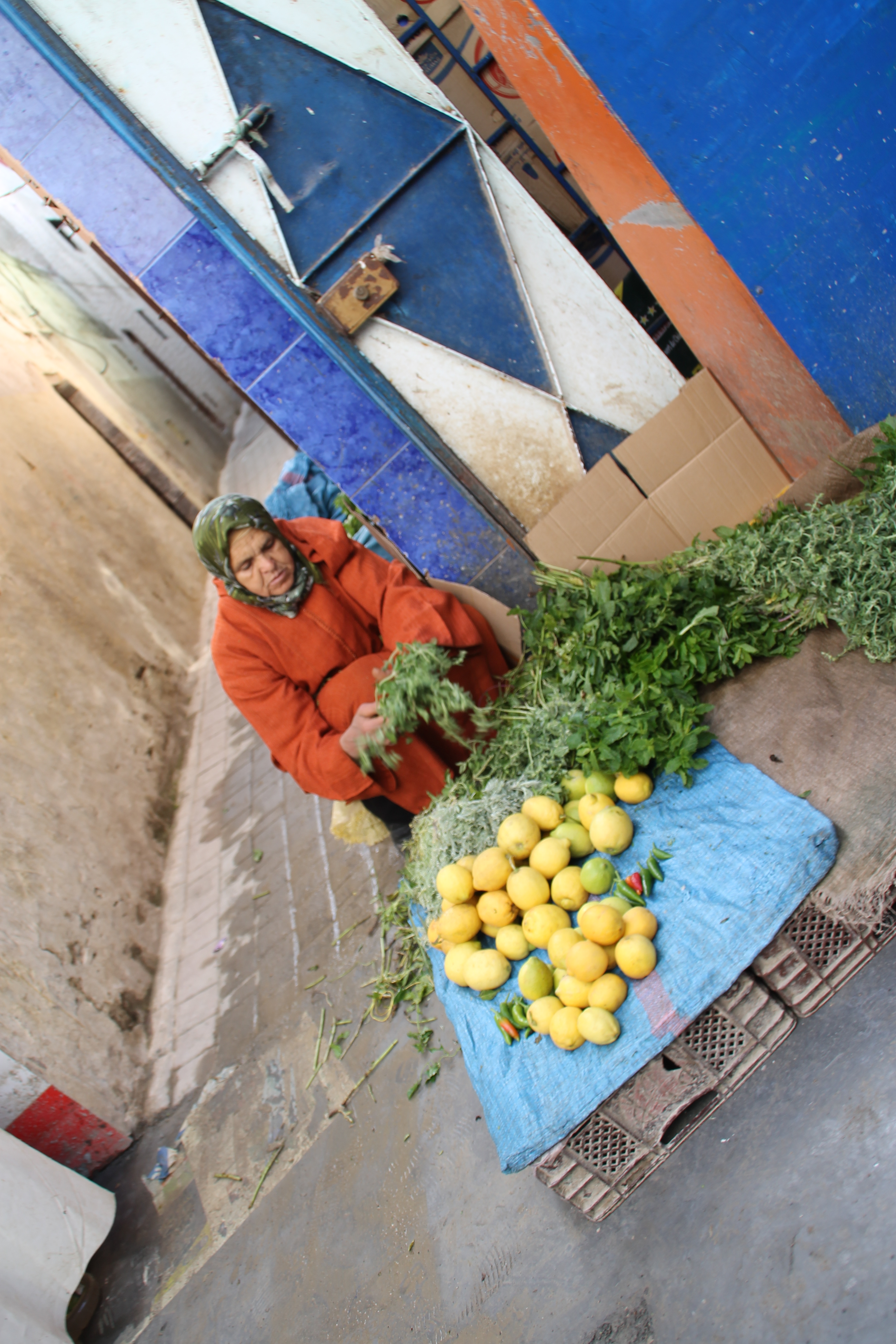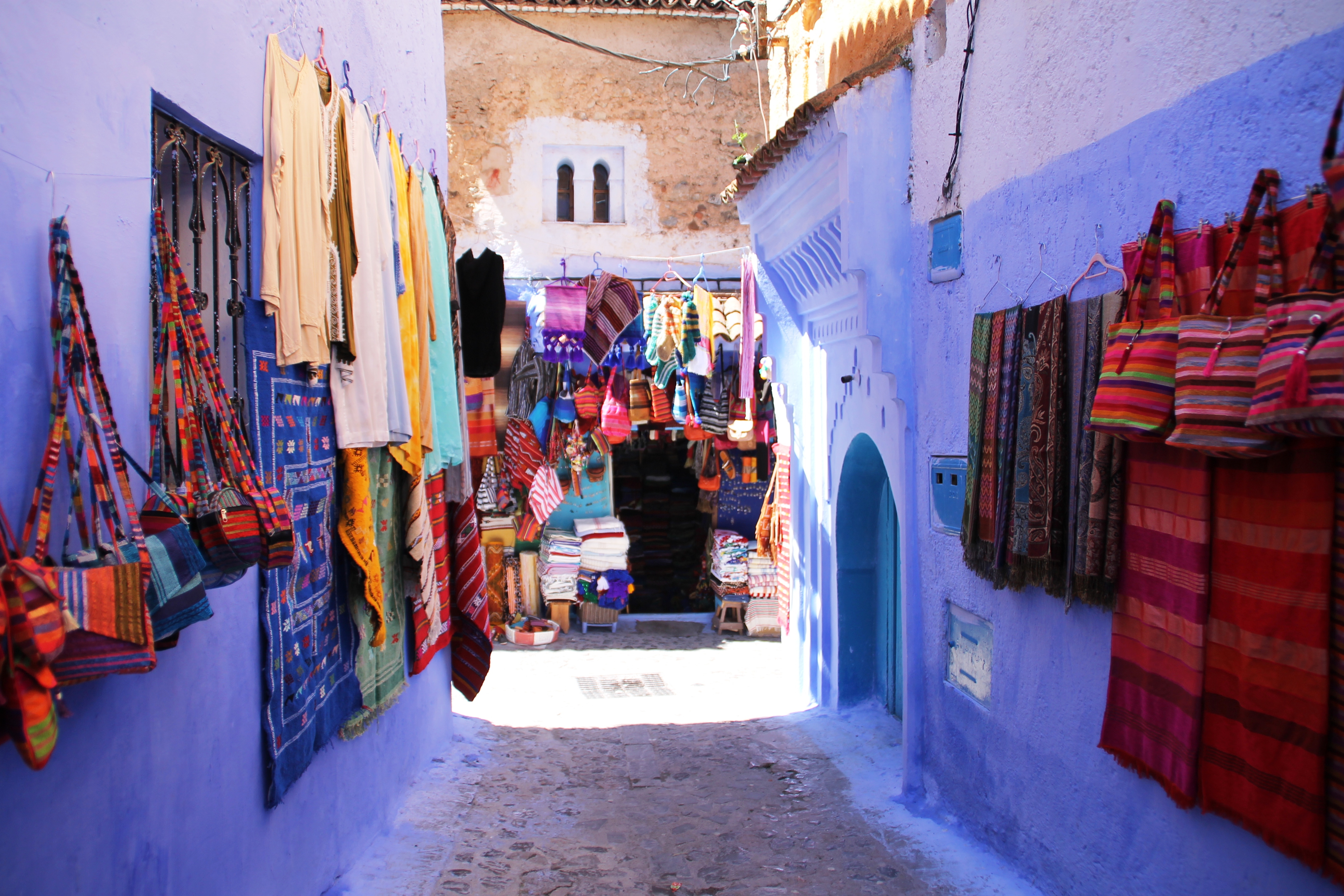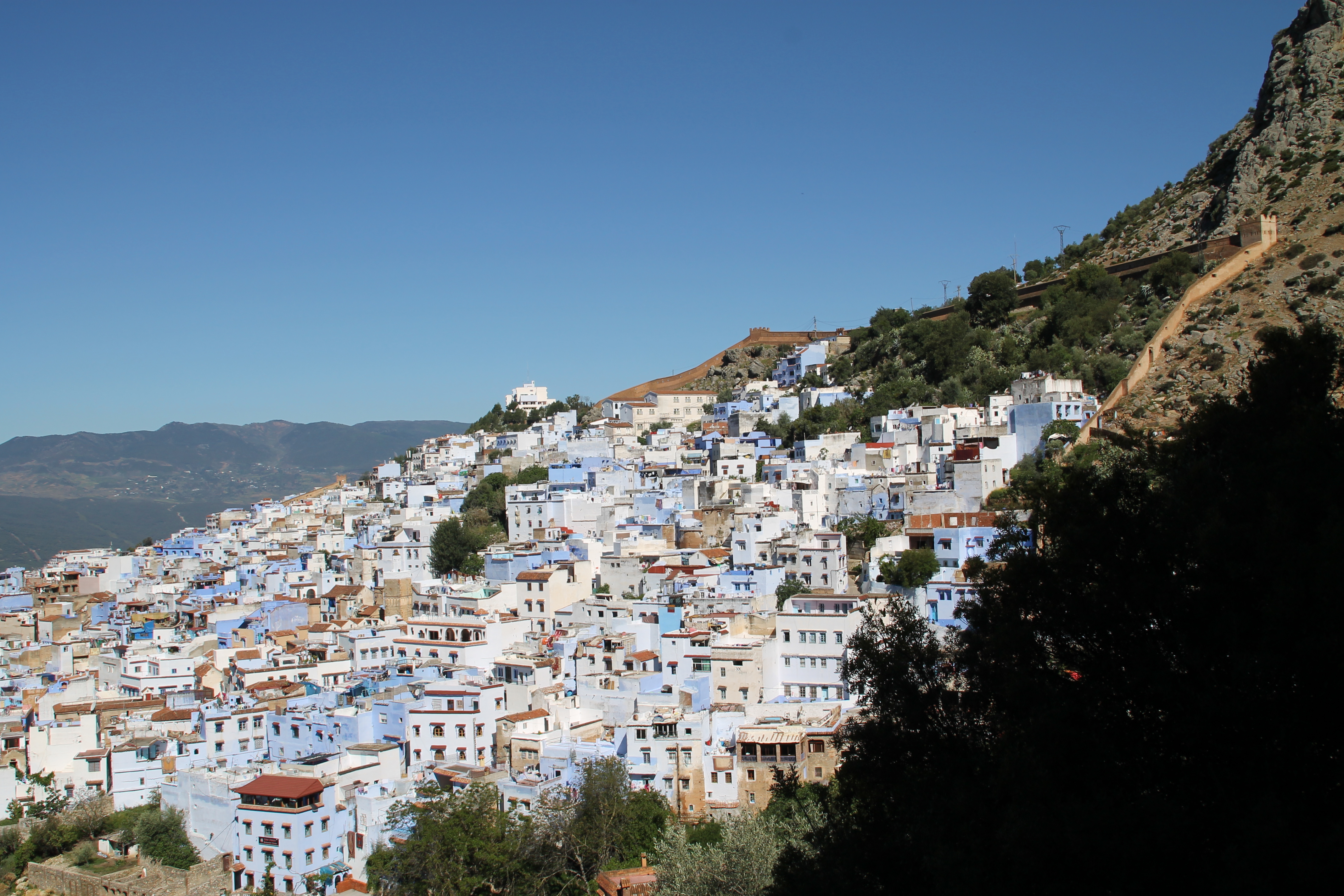When we announced that we fly to Morocco for a long weekend (literally, for two and a half days), all our friends and colleagues were concerned in our sanity. Indeed, we spent every day at least five hours on the road sitting in bus or train or plane or waiting for our flight. Flying to Brussels after work and then to Rabat-Sale. Taking a five-hour bus to and back from Chefchaouen. Returning to Rabat-Sale by train from Fez. Flying back home over Brussels. Sounds like a lot. Yes, it is. But I assure you, on our very first day we concluded: Morocco is so much worth all this travelling fuss!

On the road in Morocco
It is incredible, how different culture can be in a country that is within 3-hour-flight accessibility from good old all-settled-down Europe. Picturesque, colorful, sometimes a bit wild, vivid, bright and breaking the usual behavior rules – this is Morocco.
By arrival in and by departure from Morocco you are requested to fill in the “embarkation” form and enter the place where you stay. Be aware, sometimes the custom officers are very attentive and check the correctness of your data very precisely. Good news for Russians: we don’t need a visa to go to Morocco.
There is an ATM at the airport, so you can withdraw money in local currency – MAD, Moroccan dirhams. The rate at the time of our trip was about 1 Euro = 11 MAD.
Our adventure started directly by arrival at the Sale-Rabat airport when we faced the reality of absence of the public transport going to the city. Huge pool of old white taxi was in front of the airport. No counters. Rates are listed on a shield (100-150 MAD to Sale and 150-200 MAD to Rabat). Of course, the taxi drivers wanted more with the justification “It’s late”. They wanted 20 Euro from us for a trip that takes less than 10 minutes. One can understand that, because they have a weird system, principle of “live” queue and have to wait for their turn. No one knows how long… nevertheless, we tried to talk to the locals and tourists waiting to be picked up – without result, no one speaks English (advice number one – learn basic French phrases to be able to communicate). Despaired, we agreed to the offer to pay 15 Euro. It was absolutely overpriced, but there are pre-defined rules: only big white taxis “grand taxis” are allowed to drive between the cities and to the airport. Other taxis drive only in the city (“petit taxis”, they are blue in Rabat and Chefchaouen and red in Fez) and are equipped with a km counter. A trip costs maximum 2-3 Euro. Whatever, we reached our first destination city in Morocco, checked-in in the hotel Dar Nawfal in Sale (traditional style, nice breakfast with pancakes, good coffee and fresh orange juice) and could finally relax. By the way, you pay about 2-3 MAD p/p tourist tax for a night.
There is not so much to see in Sale, but walking on the market in old city center – medina – is always fascinating. When you stroll along the narrow market passageways, you smell fresh mint and coriander. It is appetite-arousing. I never liked coriander a lot, but in Morocco I felt an irresistible urge to get me a coriander-rich salad.
By the way, people on the markets were not very pleased to be taken pictures of… so we had to make photos secretly.

Market in Sale
To go to Rabat from Sale is very easy. Directly outside the medina, on the south, you will find several tram stations. A single ticket costs 6 MAD. The trip to Rabat lasts only 5-7 minutes. We went off at Point Hassan to enter the Rabat medina.
I liked Rabat a lot. This city has a lot to suggest. A big old medina with carpet-makers shops, endless market, nice beaches with waves where you can swim, surf (to rent a surfboard and a wetsuit costs 10 MAD/hour) or stand-up paddle.

Overviewing the haven in Rabat
If you are not in a mood to do sports (or like us, who had to go to Chefchaouen right afterwards and had no desire to sit wet and salty during 5 hours in a bus), you can just drink a coffee in one of the beach cafes and lazily watch the life happening around you. One of the exemplars of individuality and creation was a rapper in a wizard robe freely improvising on one of the fortress’ viewpoints.
A beautiful view is opens from the cementary in the upper part of medina.

Beautiful cementary in Rabat
I would highly recommend losing yourself for couple of hours among colorful leather shoes and bags, fresh fish, fruit and vegetables, oriental clothes, spices and sweet goodies. Negotiating a price is not only acceptable, it is expected. Once we were lured to a spice shop and were offered marijuana inside. In fact, in Morocco it is not rear when someone offers you to buy some hashish on the streets…

You can find everything on the market
Strolling along narrow streets in Rabat is pleasant: we were welcomed in a carpet-maker and a blacksmith shops. Unexpectedly (for Morocco), they didn’t expect us to pay. They only wanted to show us their ancient crafts. On the streets, even on the narrow market passages, the only danger is motorcyclists driving everywhere pretty fast.

In a carpet-maker shop
Everyone speaks French (except us) or Arabic. But the miserable amount of words we know was already sufficient to be polite: “merci”, “bonjour”, “au revoir”, “s’il vous plait”, “pardon” and repeated a lot of times “c’est bon” (“that’s good”). In Arabic we learned two important words: “salam” and “shukran” – “hello” and “thanks”. Actually, that was enough to explain ourselves and communicate what we need (or more often, don’t need) and how much. By the way, these prejudices about Moroccans that they are overwhelmingly intrusive are definitely overestimated. In Rabat no one wanted to sell us a carpet, so we even got a little upset. In Fez we bought a nice cover-blanket on our own initiative.
There is only one bus from Rabat to Chefchaouen. It departs daily at 15:00 (duration of this trip is 5,5 hours with a break for dinner, a single ticket costs 100 MAD). The bus starts from the CTM bus station (it is far on the south of the city, so you can’t walk there) where you can go with a blue taxi for 20 MAD. Departure delays are normal. Another option – to go by train and then switch to bus (costs 190 MAD). Then you have to start from the train station in the city center.

On the road in Rabat
By arrival in Chefchaouen many taxi drivers were awaiting the tourists. We shared a taxi with two Americans (50 MAD in total) and had a taxi driver and a guy who “sold” us the taxi. This was a short ride: the bus station is directly under the old medina. But to go to the city you have to walk uphill, what could be quite exhausting if it’s hot (and it is hot there). The “seller” brought us to our hotel and expected some tips for showing us the way. I was surprised, because we already paid the taxi and could have found the hotel on our own. Nevertheless, we paid (first we gave him 4 MAD and he was angry and offended and demanded at least 10 MAD). Then I read that it is “normal” in Morocco to give tips if someone shows you the way. This is the way how it works and money is expected from the tourists. However, for Europeans it is completely unusual to ask for money if you have shown a way to a tourist.
In Chefchaouen we stayed at Casa Miguel, another traditional hotel with great breakfast. The staff speaks good English and it was a pleasure to spend a night there. In this city many people rather speak Spanish than French, so we could breathe away – we speak poor Spanish.

Medina of Chefchaouen
Old medina of Chefchaouen is breathtaking. Literally all houses, almost without exceptions, are painted bright blue with slight color variations and thousands shades. During taking hundreds of photos we accidentally saw an elderly lady paining a church in blue, producing the beauty, so to say…

Creating the beauty
Besides the color peculiarity of the city, the locals here are dressed very specially: we met so many people dressed exceptionally that we started guessing if in 1930 a smart marketing decision came from a very clever guy who pondered about the ways to attract tourists in the small city in the mountains. Then suddenly he came up with a bright idea: “we just paint all houses blue and from now on all men are wizards (wearing magician-like cloaks) and all women are Mexican (wearing colorful hats that look much more Mexican than Moroccan)”.

A wizard
This marketing solution worked brilliantly and thousands of tourists rushed to Chefchaouen… In fact (I read about it afterwards, as these thoughts couldn’t leave me for a long time), there are several official theories why the walls were painted all shades of blue. One of them is a very pragmatic one: the blue keeps mosquitos away. Another one, the historic theory is that Jews introduced the blue when they took refuge from Hitler in the 1930s. The blue color is believed to symbolize the sky and heaven. Besides, the blue meant to serve as a reminder to lead a spiritual life. Frankly speaking, I like our theory more because it’s more fun and an element of suddenness. This or that way, the city is dazzling. Even at night you can see all its beauty in color: there are a lot of lanterns and lamps and the shops are open till late. The shades of blue only get a little darker and receive a tiny nuance of violet.

Medina of Chefchaouen
By the way, another reason of Chefchaouen popularity among the tourists is its reputation as a center of the marijuana plantations region in North Morocco. Drugs are widespread and somehow tolerated, but guys trying to sell marijuana to tourists on the streets are quite annoying.
A great place to have a lazy breakfast is the main square Plaza Uta el-Hammam in the heart of the medina. It is a perfect place to make a stop, take a seat facing the square and the walls of the Kasbah, drink some fresh mint tea or have a proper breakfast and watch the people stream. I highly recommend you to try a dish called baisara for breakfast. It’s a traditional Moroccan dish of split pea soup, served with ground cumin and olive oil. You get the spices (sweet paprika and curcuma) in separate limpets.

Baisara breakfast
Additionally, you can visit the Ras el Maa waterfall to the east of the medina walls, direct next to the entrance. It is a meeting point for locals who come to cool off, chat and do their laundry. You can also climb the hill behind the waterfall to overlook the medina from above.

A view to the Blue City from the hill next to it
As we know, many hiking tours into the Rif Mountains start in Chefchaouen, but we didn’t have enough time for that, unfortunately. Instead, after noon we headed to the bus station to catch a bus to Fez – our last destination point in this blitz-trip “Three days – three Moroccan cities”.
From the medina to the bus station (gare routiere) you can easily walk. It takes only 15-20 minutes (downhill) and you have an opportunity to briefly see a very different city outside the medina.

Other Chefchaouen
The buses from Chefchaouen to Fez go four times a day: 10:30, 13:00, 15:00 and 18:00. We wanted to catch a one-o’clock-bus but there was only one seat left. We asked at the neighbor window – the answer was easy: “Bus rouge” (red bus) and waving hand direction exit. We run to the only read bus at the station, obviously already in the process of boarding. We had luck, they had enough seats and we got two tickets for 60 MAD p/p. The bus was a little less comfortable as the CTM bus, but in general it was an easy trip. The only confusing moment was when we suddenly had to change a bus. Nevertheless, we could understand each other with the bus driver and arrived safe in Fez after 4,5-hour drive.
The bus station in Fez is situated very close to medina, you can see its walls from the station and can definitely walk to you hotel. If you are afraid to get lost on narrow winding streets of medina (that is, by the way, the biggest medina in the world), ask a local to bring you to your hotel through the endless labyrinths and give him some money for his job.

The walls of Fez Medina
Sometimes paying a local in unavoidable: for example, we couldn’t have found a tannery without help of a local. The biggest tannery was closed for a restauration, so we went to a smaller one that turned out to be the oldest in Morocco. On the entrance to the viewing point we got a bunch of mint to kill the intense smell of the animal skin being fabricated and died.

A tannery in Fez
On the way to the tannery we stopped at one of the clothes shops and bought a traditional dress for me (for only 50 DH!). It was too big (one-size), so at once the seller suggested taking it in. It was very quickly and professionally done by a very pleasant elderly man. One of the reasons I bought the dress was that our last evening in Fez I decided to wear a dress that is relatively short – knee-length. The official rules in Morocco are not so strict like in Iran, for example; you don’t have to wear a scarf or a long-sleeved and long-bottom dress. However, believe me, you feel just more comfortable and relaxed if you wear something modest and fairly long. Not sure, how it works in the cities next to the beach (Casablanca, etc.), but in Fez it worked for sure: I immediately stopped catching people while staring on my legs when I put on the long dress.
If you want to go out for a dinner in Fez, go to the Blue Gate (that is green, by the way). The restaurants there don’t have a terrace with a view over the rooftops of the city like the ones in the deep center of medina, but you will be rewarded with the nice atmosphere and moderate prices. Besides, watching the crowd strolling along the streets while sitting in a comfortable chair with a glass of mint tea is worth it. By the way, there is no alcohol in the country. You can find it only during big celebrations and on the black market. Instead, you can always count on tasty fresh mint tea, freshly squeezed orange juice and delicious coffee for small money. Buying local fruit on the market is a good idea as well: melons were sweet and juicy and small peaches are soft and fragrant… Much to our surprise, we didn’t see as much shisha bars as we expected to see there.
Going from Fez back to Rabat and thus closing the loop of the three cities we visited is way more convenient than going to Chefchaouen or to Fez from there. Trains from Fez to Rabat go every hour (you can find the timetable on the site: http://goafrica.about.com/od/Getting-to-Africa/fl/Fes-Train-Schedule-in-English.htm), the trip lasts 2,5 hours. A second class ticket costs 85 MAD. Clean, comfortable, good air-conditioning, legs freedom, departure on time, food sold on board: trains are a very convenient means of transport in Morocco.
We were quite reckless when it came to departure to the airport from Rabat: we spent some time on the market, bought something to eat, spend rest of our money. At the end, we had only 60 MAD left: that should have been more than enough to pay a “petit taxi” (the fair one, with a counter) to bring us to the airport. Here we faced the reality: small taxis are not allowed to drive outside the city. “Grand taxis” have a monopoly in this regard. We have had to pay 15 Euro again for a 15 min trip. We tried to explain a “petit taxi” driver that he can drop us at the intersection before the airport. But instead he brought us to the train station. We started getting rattled and the taxi driver tried to calm us down and said he will find us a “grand taxi” driver for the money we have. Indeed, he did it. When we jumped into the car, a controller came to the driver and they had a short argument: obviously, the “live queue” principle works here as well. The taxi-driver was openly disappointed with his deal, but we had no more money left than we had. So he successfully drove us to the airport.
Departure was easy: filling in the d’embarkment form, going through the controls and catching our flight; BAU – business as usual.
I liked Morocco very much. This incredible two-and-a-half-day trip was definitely too short but absolutely worthy all this stress. I’m sure, we will return to Morocco for a longer time for a night over in Sahara, surfing in Agadir and rubbernecking on the market in Marrakesh.

Entrance to Medina of Rabat














[…] days. That time we visited the northern Morocco and its three cities Rabat, Chefchaouen and Fes (A weekend away in Morocco). Many people told us afterwards that we were crazy, to travel so fast and so intense. However, […]